Imagine holding a guitar that defies the conventional wisdom of wood and weight, offering a sublime blend of resilience and tone – that’s the allure of the *carbon fiber guitar neck*. This innovation isn’t just a flight of fancy; it represents a *profound shift in how we perceive guitar neck materials*. According to recent studies, guitars featuring carbon fiber necks exhibit up to 50% less warping over time compared to traditional wood, an exciting prospect for any musician tired of battling seasonal swelling and shrinking.
As someone who has dedicated years to understanding *instrument materials*, I believe that the choice of guitar neck can significantly influence *playability and sound*. My journey with carbon fiber necks began with skepticism but quickly transformed into admiration as I experienced their unique advantages firsthand. The meticulous construction process and undeniable longevity set these necks apart, promising a new horizon for guitarists seeking durability without compromising performance. Join me as we delve into the world of carbon fiber guitar necks, exploring their benefits, construction nuances, and how they stack up against their wooden counterparts.
What are Carbon Fiber Guitar Necks?
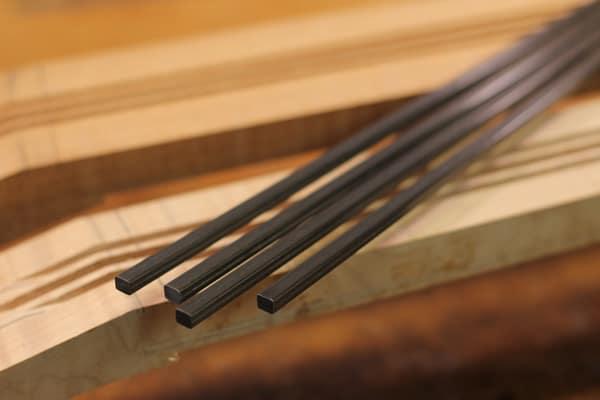
In my lutherie journey, I’ve come across a myriad of materials each with its unique charm, but carbon fiber stands out due to its extraordinary combination of *innovation and tradition*. *What exactly sets carbon fiber apart in the world of guitar necks?* Carbon fiber guitar necks are crafted using **high-strength carbon fibers** bonded with resin to create a component that’s not only incredibly *lightweight* but also *remarkably resilient*. This material inherently resists the warping and temperature-induced issues that traditionally plague wooden necks.
From my experience, the allure of carbon fiber lies in its ability to maintain *structural integrity* regardless of environmental conditions. Unlike wood, which swells and contracts with humidity changes, carbon fiber remains unfazed, providing a consistently reliable performance. This makes it a particularly attractive choice for traveling musicians. In the realm of guitar neck construction, these necks can be engineered to achieve precisely desired specifications with greater ease, thanks to their moldable nature and uniform strength throughout the structure.
Moreover, my ventures into crafting guitars have revealed that carbon fiber necks offer a unique tonal quality. While some purists might miss the warmer overtones of wood, the clarity and sustain I’ve observed offer a refreshing departure worth considering. As we delve deeper, you’ll see how these distinct characteristics make carbon fiber a strategic choice for modern luthiers looking to push the boundaries of traditional guitar craftsmanship.
Why Choose Carbon Fiber Guitar Necks?
Durability and Longevity

As an engineer, I encounter numerous materials boasting various strengths, but few match the impressive durability of carbon fiber necks. Carbon fiber guitar necks are exceptionally robust, resisting the warping and damage often caused by humidity and temperature changes. These qualities ensure a consistent sound quality and performance, season after season. The toughness of carbon fiber translates into instruments that can withstand the rigors of frequent gigging or travel, eliminating concerns about neck adjustments or unforeseen repairs associated with traditional materials.
The longevity of carbon fiber is an essential consideration when choosing a guitar neck, offering a long-term investment for musicians keen on maintaining their instrument’s quality over time. Not only does this strength contribute to the neck’s sound stability, but it also ensures smooth playability and offers peace of mind to musicians who rely on their instruments for professional commitments. As we explore further, the lightweight nature of these necks combined with their remarkable resilience makes them an attractive option for both performers and hobbyists alike.
Lightweight Options
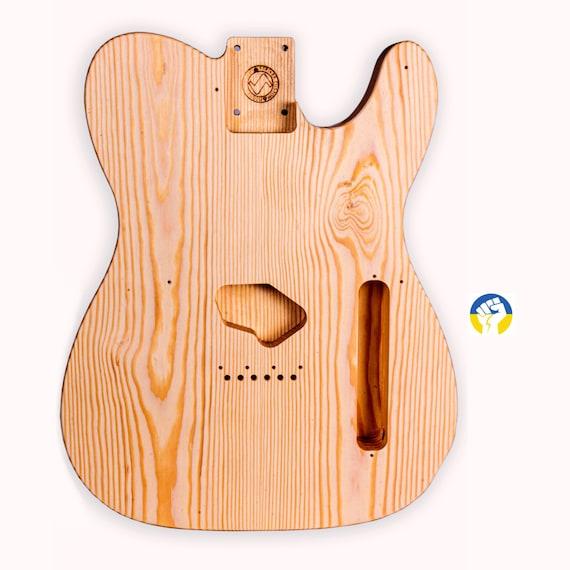
In my years of playing and examining musical instruments, I’ve often noticed how the weight of a guitar can significantly affect a musician’s performance. This is where carbon fiber guitar necks truly shine. The innovation of lightweight guitar neck options plays a crucial role in minimizing fatigue during extended sessions and maintaining a fluid interaction between musician and instrument. Carbon fiber is not only remarkably lighter but also retains superior structural integrity. This means musicians can enjoy the comfort and agility of a lighter instrument while still benefiting from exceptional strength and stability. Transitioning from the discussion on durability and longevity, it’s clear that lightweight attributes of carbon fiber contribute substantially to versatility and ease of play, reinforcing its appeal over traditional wood necks.
Travel-Friendly Features
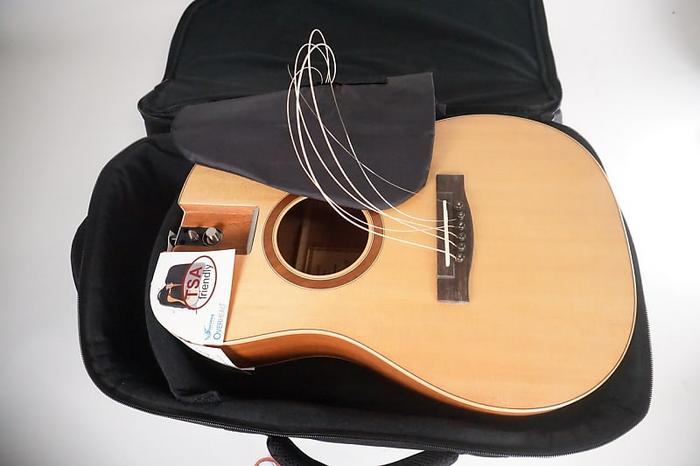
Traveling with traditional guitar necks often left me concerned about *temperature changes* and *humidity levels*. However, the **travel-friendly guitar necks** crafted from carbon fiber *excel in resilience*, making them a *game-changer for musicians on the road*. Having personally experienced the *frequent fluctuations of international climates*, I’ve found carbon fiber’s *immunity to environmental stressors*—like warping and cracking—indispensable.
The durability of carbon fiber ensures *consistent tuning stability*, a crucial aspect when performing across diverse venues. Additionally, the **lightweight design** contributes to *ease of transportation*, significantly reducing *physical burden*. These features highlight why, for me, a *carbon fiber neck is not only preferable but essential* for my musical travels. As I delve into the construction process further, it’s clear how this innovation outperforms traditional materials.
How are Carbon Fiber Guitar Necks Made?
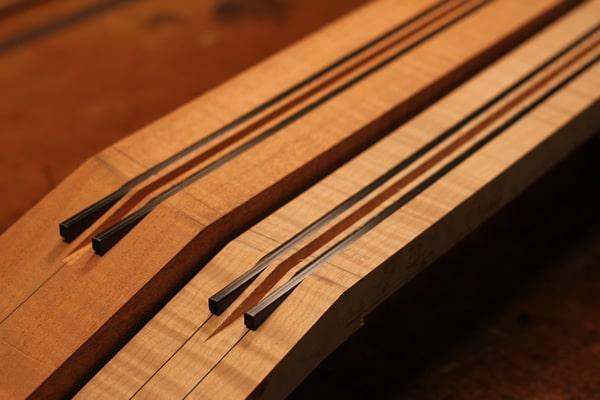
What secrets lie behind the crafting of a carbon fiber guitar neck? The construction process for these innovative necks fascinates me; it’s a blend of technology and craftsmanship that results in superior performance. Understanding the intricacies of guitar neck construction reveals why carbon fiber is a game-changer for musicians.
The journey begins with selecting the right carbon fiber material, known for its remarkable strength-to-weight ratio. This material is layered meticulously, with each layer positioned to complement the structural demands of the neck. The arrangement is crucial, ensuring the neck’s resilience and stability under tension.
Once the layers are in place, the assembly undergoes a high-pressure, high-temperature molding process. This step is where the neck’s precise shape and durability are born. The mold is designed to accommodate various models and preferences, ensuring a consistent yet customizable product. The precision and control at this stage fascinate me; they not only replicate the natural feel of traditional necks but also add the unwavering reliability carbon fiber is known for.
After molding, the unfinished neck is meticulously polished, a process requiring a delicate touch and an eye for perfection. This step blends craftsmanship with technology, resulting in a sleek finish that’s both visually appealing and functional.
Each stage of creating a carbon fiber guitar neck doesn’t just echo modern engineering excellently; it also pays homage to centuries of musical tradition, all while propelling the guitar into the future. For me, witnessing this process is like watching art and science in harmony, crafting not just an instrument part but a medium for musical expression.
Carbon Fiber vs. Wood Guitar Necks

Is the classic wooden neck really better than its carbon fiber counterpart? This question has sparked countless debates among musicians and luthiers alike. As someone who’s spent years in pursuit of the perfect tone, I’ve found myself exploring both carbon fiber and wood guitar necks extensively. *Carbon fiber vs wood guitar neck* presents compelling considerations not just in construction, but in their impact on sound and playability.
From my experience, *wooden necks* have the charm of tradition. The natural grain, warmth, and resonance of wood are undeniably part of its allure. Many players swear by the feel of a wooden neck—the subtle nuances, the way it resonates differently with each stroke of the strings. I’ve felt that organic connection too, that seems almost alive in your hands. However, these features come with their own set of challenges, such as susceptibility to climate changes and the need for regular maintenance.
On the flip side, carbon fiber introduces a modern twist to guitar neck materials. Though I was initially skeptical, hands-on experience revealed its remarkable benefits. *Carbon fiber* necks are highly resistant to temperature and humidity changes, maintaining stability where wood might falter. Their durability and lightweight nature are *noteworthy*, making them ideal for travel guitars or for musicians who often perform in diverse climates. Moreover, while they may lack the traditional character of wood, they offer a clarity and precision in tone that some players, including myself, find incredibly appealing.
The ongoing debate of *carbon fiber vs wood* ultimately boils down to personal preference, reflecting the endless variety of needs and tastes among guitarists. As we navigate the evolving landscape of musical expression, the choice between these materials is fundamentally a choice of identity in sound. The key lies in understanding how each material aligns with your personal style and needs as a musician.
Considerations for Installation

Are you prepared to unlock the full potential of your guitar with a new neck? The *installation of carbon fiber necks* is a critical step that can transform your guitar-playing experience, but it requires meticulous attention to detail and a deep understanding of the instrument’s anatomy. *Drawing from my extensive background in instrument design*, I can assure you that proper installation is crucial for maximizing the benefits of a carbon fiber neck. This upgrade promises enhanced durability and performance, but to truly harness these advantages, the installation must be executed with precision.
When considering a *guitar neck upgrade*, it’s important to evaluate the compatibility of the new neck with your existing setup. Carbon fiber, with its unique properties, requires a different approach compared to traditional materials like wood. Ensuring the neck’s fit with the body, understanding the tension it introduces, and calibrating the action and intonation are pivotal. These adjustments are not just technical but also require an artistic touch, something I’ve learned through years of hands-on experience.
The expertise I’ve gained over time tells me that every guitar is distinct, and so is every installation. It’s not merely about replacing parts; it’s about integrating technology to elevate artistry. As you embark on this upgrade journey, remember that the installation isn’t just a step—it’s the bridge between potential and performance.
Reviews of Carbon Fiber Guitar Necks
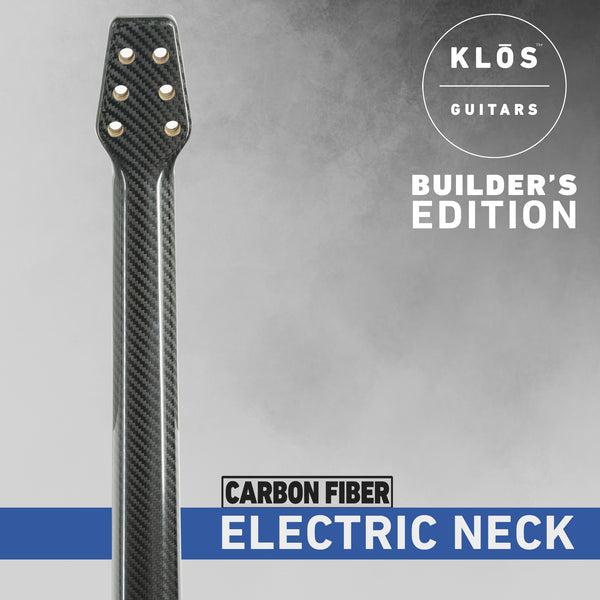
As an editor and contributor to various lutherie publications, I have developed a keen eye for evaluating products in our field—and carbon fiber guitars are among the most intriguing. I approach each review with a sense of curiosity and commitment to uncovering what truly sets these innovations apart from their traditional counterparts. This brings us to the heart of our discussion: What are musicians saying about their experiences with carbon fiber necks?? The influx of carbon fiber guitar neck reviews suggests a transformative shift in our understanding of guitar construction.
Evaluating these reviews, it’s evident that musicians appreciate the stability and consistency offered by carbon fiber over traditional wood. One acclaimed aspect is the enhanced resilience to environmental fluctuations, a boon for traveling musicians and those residing in diverse climates. ”No more constant tuning adjustments,” exclaims one satisfied user, emphasizing the reliability of their sound. Similarly, several reviewers note the lightweight nature of carbon fiber, a significant advantage during long performances.
Yet, it’s not just practicality that draws praise. The tonal qualities of carbon fiber necks—often described as crisp and clear—meet with varied responses, with some musicians needing time to adjust to the distinct acoustics. Despite this, many find its unique resonance an exciting avenue for creative exploration. Furthermore, the complement of carbon fiber guitar accessories often enhances the overall playing experience, offering seamless integration with this innovative material. Clearly, musicians are voicing a strong appreciation for the benefits of carbon fiber, while also openly discussing areas of personal preference and adaptation. These candid insights chart a new course in guitar craftsmanship that both challenges tradition and excites innovation.
FAQs
What are the benefits of using carbon fiber for guitar necks?
How is a carbon fiber guitar neck constructed?
How do carbon fiber guitar necks compare to traditional wooden necks?
Conclusion
Can carbon fiber necks redefine how we play and experience guitar music? Reflecting on the benefits of carbon fiber necks, I can confidently say they offer an innovative solution for modern musicians seeking reliability and performance. These necks excel in durability and longevity, providing a steadfast alternative to traditional materials prone to warping and environmental changes. Their lightweight nature and travel-friendly features also make them an excellent choice for musicians on the go.
Understanding the intricacies of how carbon fiber guitar necks are made sheds light on their impressive resilience and tonal qualities. When compared to wood, these necks deliver a consistent playing experience, free from the subtle shifts that can affect performance. Personal experiences and reviews from fellow musicians highlight a collective appreciation for this game-changing innovation.
In conclusion, embracing carbon fiber necks could indeed revolutionize our relationship with guitars, merging cutting-edge technology with time-tested musicality. The journey from traditional to modern guitar necks signals a compelling shift, inviting us all to reconsider our musical tools and their impact on performance.
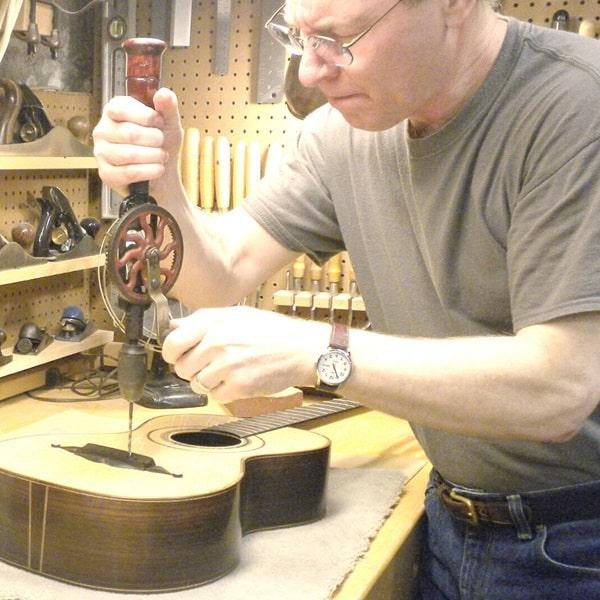
R.M. Mottola, an engineer-turned-luthier, revolutionizes stringed instrument design with his deep focus on acoustics and ergonomics since 1994. As editor of the Savart Journal and a key contributor to American Lutherie, Mottola merges science with artistry in lutherie. He enriches the field with his extensive knowledge, shared through his Liutaio Mottola website, making him a beacon in the world of modern instrument craftsmanship.
